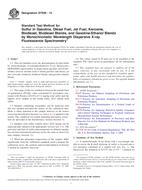We need your consent to use the individual data so that you can see information about your interests, among other things. Click "OK" to give your consent.
ASTM D7039-13
Standard Test Method for Sulfur in Gasoline, Diesel Fuel, Jet Fuel, Kerosine, Biodiesel, Biodiesel Blends, and Gasoline-Ethanol Blends by Monochromatic Wavelength Dispersive X-ray Fluorescence Spectrometry
STANDARD published on 15.9.2013
The information about the standard:
Designation standards: ASTM D7039-13
Note: WITHDRAWN
Publication date standards: 15.9.2013
SKU: NS-37387
The number of pages: 11
Approximate weight : 33 g (0.07 lbs)
Country: American technical standard
Category: Technical standards ASTM
Annotation of standard text ASTM D7039-13 :
Keywords:
analysis, biodiesel, diesel, fuel, gasoline, jet fuel, kerosine, monochromatic X ray, MWDXRF, spectrometry, sulfur, wavelength dispersive X-ray fluorescence, WDXRF, X-ray, ICS Number Code 75.160.20 (Liquid fuels)
Additional information
| Significance and Use | ||||||||||||
|
4.1 This test method provides for the precise measurement of the total sulfur content of samples within the scope of this test method with minimal sample preparation and analyst involvement. The typical time for each analysis is five minutes. 4.2 Knowledge of the sulfur content of diesel fuels, gasolines, and refinery process streams used to blend gasolines is important for process control as well as the prediction and control of operational problems such as unit corrosion and catalyst poisoning, and in the blending of products to commodity specifications. 4.3 Various federal, state, and local agencies regulate the sulfur content of some petroleum products, including gasoline and diesel fuel. Unbiased and precise determination of sulfur in these products is critical to compliance with regulatory standards. |
||||||||||||
| 1. Scope | ||||||||||||
|
1.1 This test method covers the determination of total sulfur by monochromatic wavelength-dispersive X-ray fluorescence (MWDXRF) spectrometry in single-phase gasoline, diesel fuel, refinery process streams used to blend gasoline and diesel, jet fuel, kerosine, biodiesel, biodiesel blends, and gasoline-ethanol blends. 1.2 The range of this test method is
between the pooled limit of quantitation (PLOQ) value (calculated
by procedures consistent with Practice D6259) of 3.2 mg/kg total
sulfur and the highest level sample in the round robin, 2822 mg/kg
total sulfur.
1.3 Samples containing oxygenates can be analyzed with this test method provided the matrix of the calibration standards is either matched to the sample matrices or the matrix correction described in Section 5 or Annex A1 is applied to the results. The conditions for matrix matching and matrix correction are provided in the Interferences section (Section 5). 1.4 Samples with sulfur content above 2822 mg/kg can be analyzed after dilution with appropriate solvent (see 1.5 When the elemental composition of the samples differ significantly from the calibration standards used to prepare the calibration curve, the cautions and recommendation in Section 5 should be carefully observed. 1.6 The values stated in SI units are to be regarded as the standard. The values given in parentheses are for information only. 1.7 This standard does not
purport to address all of the safety concerns, if any, associated
with its use. It is the responsibility of the user of this standard
to establish appropriate safety and health practices and determine
the applicability of regulatory limitations prior to use.
Standard Practice for Determination of
Precision and Bias Data for Use in Test Methods for Petroleum
Products, Liquid Fuels, and Lubricants Standard Practice for Applying
Statistical Quality Assurance and Control Charting Techniques to
Evaluate Analytical Measurement System Performance (Includes all
amendments and changes 12/12/2023). Standard Practice for Automatic Sampling
of Petroleum and Petroleum Products (Includes all amendments and
changes 3/24/2023). Standard Practice for Determination of a
Pooled Limit of Quantitation for a Test Method Standard Practice for Manual Sampling of
Petroleum and Petroleum Products Standard Practice for Optimization,
Sample Handling, Calibration, and Validation of X-ray Fluorescence
Spectrometry Methods for Elemental Analysis of Petroleum Products
and Lubricants |
We recommend:
Technical standards updating
Do you want to make sure you use only the valid technical standards?
We can offer you a solution which will provide you a monthly overview concerning the updating of standards which you use.
Would you like to know more? Look at this page.




 Cookies
Cookies
